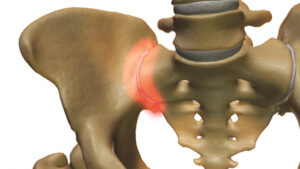We Are Open For Sacroiliac Joint Disorders Treatment in Gurgaon!
Fill the form and let us call you back.
Sacroiliac Joint Disorders Treatment at Physioheal Physiotherapy, Gurgaon
Sacroiliac Joint Disorders and the Role of Physiotherapy
The sacroiliac joint (SI joint) is a vital junction between the hip and spine. Situated in the lower back, just above each buttock, this joint can be prone to disorders that cause discomfort and hinder daily activities. In this detailed guide, we explore the intricacies of sacroiliac joint disorders, including their symptoms, causes, diagnosis, treatment options, and the pivotal role that physiotherapy plays in managing and alleviating these conditions.

Symptoms of Sacroiliac Joint Disorders
One common indicator of sacroiliac joint disorders is pain localized on one side of the back, just above the buttock. Individuals with this condition might also experience pain radiating to the groin or the front and outside of the thigh. Additional symptoms include:
- Reduced range of movement
- Swelling and inflammation
- Stiffness
- Weakness
- Numbness
- Muscle spasms
- Tingling or pins and needles sensation
Causes of Sacroiliac Joint Disorders
Excessive movement within the sacroiliac joint is a primary contributor to sacroiliac joint disorders. This heightened movement strains ligaments and other soft tissues that support the joint, leading to pain and inflammation. Prolonged stress and overstretching of these structures can exacerbate the condition.
Diagnosis of Sacroiliac Joint Disorders
Accurate diagnosis is crucial for effective treatment. Physiotherapists evaluate the severity of the disorder and tailor treatment plans accordingly. Techniques include physical examinations, medical history analysis, and possibly imaging tests.
Treatment Options for Sacroiliac Joint Disorders
Physiotherapy offers a multifaceted approach to treating sacroiliac joint disorders. A personalized treatment plan may encompass:
- Hydrotherapy: Immersing in water reduces strain on the joint, easing pain and promoting healing.
- Acupuncture: Stimulating specific points can alleviate pain and enhance joint function.
- Exercise Programmes: Tailored exercises strengthen supporting muscles and enhance joint stability.
- Soft Tissue Treatment: Techniques like massage and myofascial release address muscular tension and promote relaxation.
The Importance of Timely Intervention
Ignoring the symptoms of a sacroiliac joint disorder and engaging in activities that exacerbate pain can lead to worsened conditions and prolonged recovery times. It’s crucial to seek professional intervention promptly.
Recovery and Outlook
When properly diagnosed and treated, sacroiliac joint disorders rarely result in long-term effects. Recovery typically takes several weeks, but severity can influence duration. Proper care, guided by expert physiotherapists, can significantly expedite the healing process.
Trust Physioheal Physiotherapy for Comprehensive Care
For top-notch sacroiliac joint disorder treatment, turn to Physioheal Physiotherapy Gurgaon, helmed by Dr. Divya Gaur. Our expert physiotherapists provide individualized rehabilitation plans, ensuring a successful recovery journey. To schedule an appointment, reach us at +91-9999259307, book online, or request a phone consultation. Regain your mobility and comfort with Physioheal Physiotherapy.
